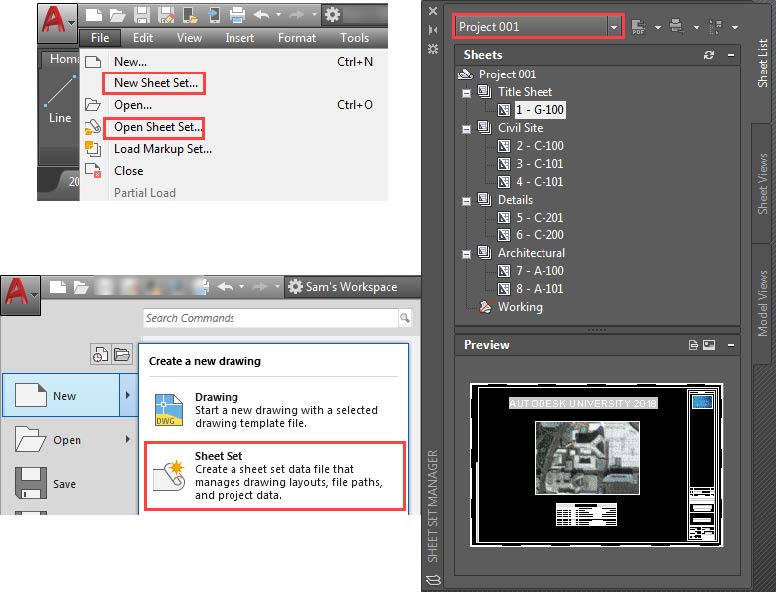Seamless Collaboration: Navigating AutoCAD’s Sheet Set Manager for Drawing Management

Introduction:
AutoCAD, a cornerstone in the field of Computer-Aided Design (CAD), offers a myriad of tools designed to streamline workflows and enhance efficiency in the creation and management of drawings. Among these tools, the AutoCAD Sheet Set Manager stands out as a powerful asset for organizing, coordinating, and managing multiple drawings within a project. In this extensive guide, we will delve into the intricate details of AutoCAD’s Sheet Set Manager, unraveling its functionalities, applications, and providing a roadmap for elevating your proficiency in drawing management.
Section 1: Understanding the Essence of AutoCAD’s Sheet Set Manager
Defining Drawing Sets:
In complex design projects, drawings often comprise multiple sheets, each representing a different aspect or view of the design. AutoCAD’s Sheet Set Manager serves as a centralized hub for organizing and managing these drawing sets, offering a structured approach to project documentation.
The Role of Sheet Set Manager:
The Sheet Set Manager in AutoCAD is a versatile tool that allows users to create, organize, and publish sets of drawings efficiently. It facilitates consistent drawing standards, reduces errors, and enhances collaboration among design team members by providing a cohesive platform for managing project documentation.
Section 2: Activating the Sheet Set Manager
Step 1: Accessing the Sheet Set Manager:
To activate the Sheet Set Manager in AutoCAD, users can either use the “SHEETSET” command or navigate to the “View” tab on the ribbon and select “Sheet Set Manager.” This action opens a dedicated interface where users can manage their drawing sets.
Step 2: Navigating the Sheet Set Manager Interface:
The Sheet Set Manager interface consists of various tabs, panels, and tree views that facilitate the organization of drawing sets. Understanding the layout of this interface is essential for efficient drawing management.
Section 3: Creating a New Sheet Set
Step 1: Initiating a New Sheet Set:
Users can create a new sheet set by selecting the “New Sheet Set” option within the Sheet Set Manager interface. This action opens a wizard that guides users through the process of defining the properties and settings for the new sheet set.
Step 2: Defining Sheet Set Properties:
In the wizard, users can specify essential details such as the title, number, and description of the sheet set. Additionally, users can set properties related to sheet creation, numbering conventions, and other project-specific parameters.
Section 4: Adding Drawings to a Sheet Set
Step 1: Adding Existing Drawings:
Once a sheet set is created, users can add existing drawings to it. This involves specifying the location of the drawings and selecting the ones to be included in the sheet set. AutoCAD automatically gathers information about each drawing, such as its layout and sheet number.
Step 2: Managing Drawing Data:
The Sheet Set Manager allows users to review and edit drawing data associated with each sheet. This includes information such as sheet numbers, titles, and revisions. Any changes made within the Sheet Set Manager are reflected in the actual drawing files.
Section 5: Organizing Sheets and Subsets
Step 1: Creating Sheet Categories:
To enhance organization, users can create sheet categories within a sheet set. These categories help group sheets based on disciplines, phases, or any other relevant criteria. This hierarchical organization simplifies navigation and retrieval of specific sheets.
Step 2: Establishing Sheet Subsets:
Sheet subsets further refine the organization by grouping sheets within categories. This feature is particularly useful in large projects with numerous sheets, allowing users to create logical subsets for efficient navigation and management.
Section 6: Automating Sheet Index Creation
Step 1: Generating a Sheet Index:
AutoCAD’s Sheet Set Manager automates the process of creating a sheet index. Users can choose the information to include in the index, such as sheet numbers, titles, and revisions. The generated sheet index provides a comprehensive overview of the entire drawing set.
Step 2: Updating Sheet Index Information:
As the project evolves, users can easily update the sheet index within the Sheet Set Manager. Changes made to individual sheets, such as revisions or title updates, are automatically reflected in the sheet index, ensuring accuracy and consistency.
Section 7: Publishing Sheet Sets
Step 1: Batch Plotting:
One of the key advantages of the Sheet Set Manager is its ability to facilitate batch plotting. Users can select multiple sheets or the entire drawing set and initiate the plotting process, streamlining the production of printed or digital output.
Step 2: Configuring Plotting Settings:
AutoCAD’s Sheet Set Manager allows users to configure plotting settings for the entire sheet set or individual subsets. This includes specifying plot styles, paper sizes, and other parameters to ensure a standardized and efficient plotting process.
Section 8: Collaborative Workflows with Sheet Sets
Step 1: Collaborative Editing:
Sheet Set Manager enhances collaboration by providing a centralized platform for collaborative editing. Multiple team members can work on different sheets simultaneously, and changes are seamlessly synchronized within the sheet set.
Step 2: Project Standards Enforcement:
The Sheet Set Manager serves as a tool for enforcing project standards. By centralizing sheet data and drawing properties, it ensures that all team members adhere to consistent conventions, fostering a unified and professional project documentation approach.
Section 9: Dynamic Sheet Set Attributes
Step 1: Leveraging Fields:
AutoCAD’s Sheet Set Manager introduces dynamic attributes using fields. Fields are placeholders for information that automatically update based on changes made within the drawing or sheet set. This dynamic attribute functionality enhances the accuracy of project documentation.
Step 2: Customizing Fields for Dynamic Data:
Users can customize fields within the Sheet Set Manager to display dynamic data such as sheet titles, numbers, and revision information. This customization ensures that the information presented in sheets and indexes remains up-to-date and accurate throughout the project lifecycle.
Section 10: Tips for Optimal Sheet Set Manager Usage
Tip 1: Consistent Naming Conventions:
Maintain consistent naming conventions for sheets, categories, and subsets within the Sheet Set Manager. This practice enhances organization and simplifies navigation, especially in projects with a large number of drawings.
Tip 2: Regular Backups:
Periodically backup sheet sets to ensure data integrity. AutoCAD’s Sheet Set Manager allows users to export and import sheet sets, providing a safety net in case of unexpected data loss or system issues.
Section 11: Troubleshooting Sheet Set Manager Issues
Issue 1: Missing Drawings:
If drawings appear to be missing within the Sheet Set Manager, verify the file paths and ensure that the drawings are accessible from the specified locations. Updating file paths can resolve issues related to missing drawings.
Issue 2: Plotting Errors:
In case of plotting errors, review the plotting settings within the Sheet Set Manager. Ensure that the correct plot styles, paper sizes, and other parameters are configured to match the project requirements.
Section 12: Saving Time and Boosting Productivity
Step 1: Time-Efficient Drawing Management:
By mastering AutoCAD’s Sheet Set Manager, designers can streamline the drawing management process, saving valuable time and reducing the likelihood of errors. This efficiency becomes particularly evident in projects with extensive drawing sets.
Step 2: Organization Reinvented:
As users become adept at leveraging the Sheet Set Manager, they unlock a new era of organization within their AutoCAD projects. The tool becomes a catalyst for precision, collaboration, and consistency, redefining the way designers approach and manage drawing sets.
Conclusion:
AutoCAD’s Sheet Set Manager emerges as a pivotal tool in the arsenal of design professionals, offering a structured and efficient approach to drawing management. This comprehensive guide has navigated the intricate landscape of the Sheet Set Manager, from its activation and interface to the creation, organization, and publishing of drawing sets. As you embark on your journey to master the art of drawing management, let the Sheet Set Manager be your guide to a new era of organization, collaboration, and efficiency. Embrace the structured possibilities, embrace the efficiency – let AutoCAD’s Sheet Set Manager redefine the way you organize and manage your drawing sets.






